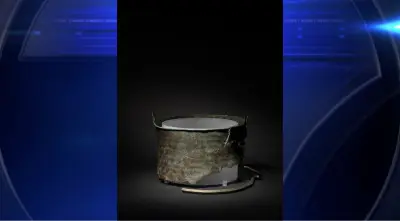Anglo-Saxons buried a mysterious vessel over a millennium ago. Archaeologists discovered its contents

CNN Archaeologists have uncovered a key component of a mysterious artifact at Sutton Hoo a National Trust site in Suffolk England famous for the seventh century Anglo-Saxon ghost ship burial discovered in a mound between and The fragments of the sixth century Byzantine bucket have fascinated researchers since a tractor harrow accidentally unearthed the pieces in Researchers have long questioned the purpose of the artifact which depicts a North African hunting scene complete with warriors a range of weaponry lions and a hunting dog Experts believe the bucket came from the Byzantine Empire and was crafted in Antioch located in modern-day Turkey before finding its way to the eastern coast of Britain a century later Excavations in contributed more pieces to the object called the Bromeswell bucket But the entire base of the vessel has proved as elusive as the reasons why it s present at an Anglo-Saxon site Now the Bromeswell puzzle is a little more complete New excavations last summer unearthed a block of dirt containing pieces of the bucket A careful analysis revealed the entire base which includes embellishments that complete feet paws shields of figures as well as the missing face of one of the warriors The gang also uncovered the bucket s surprising contents cremated animal and human remains which shed more light on why the vessel was buried Alongside the burnt bones researchers determined an unexpectedly intact comb that may contain DNA evidence of the person likely of high status who was laid to rest more than a thousand years ago Unexpected grave goods The dirt block went through CT scans and X-rays at the University of Bradford before being sent to the York Archaeological Trust for a deeper analysis in November A research squad with experience in studying human bones organic remains and conservation meticulously removed soil inside the bucket analyzing each fragment as it slowly appeared The careful approach uncovered cremated human bones which included parts of an ankle bone and a skull vault or the protective upper part of the skull according to a release from the National Trust The researchers also identified remnants of animal bone and an initial analysis suggests the pieces came from something larger than a pig The company noted that horses were often part of early Anglo-Saxon cremation pyres to reflect the elevated status of the individual who had died The tight cluster of the bone remnants as well as chosen curious unknown fibers suggest the remains were originally kept in a bag that was placed in the bucket However chosen bone fragments were also unveiled right outside of the bucket and copper-alloy staining from the bucket on the bones signals they were buried outside of the vessel at the same time the researchers commented Both the human and animal bones are undergoing further research and radiocarbon dating to provide additional context Several cremation burials at Sutton Hoo were placed in vessels such as ceramic pots and bronze bowls including an impressive bronze hanging bowl on display in the High Hall exhibition But buckets such as these are rare and there hasn t ever been one determined with cremated remains inside commented Laura Howarth archaeology and engagement manager for the National Trust s Sutton Hoo site in an email The initial scans also suggested there were grave goods within the bucket and the researchers painstakingly retrieved the delicate but largely intact double-sided comb with fine tooth and wider tooth sides likely made from an antler The comb unlike the bones had not been burned Combs made from bone and antler have been retrieved from male and female burials alike and different sizes suggest they were used for grooming hair beards and removing lice The acidic soil at Sutton Hoo which rotted away the wood of the Anglo-Saxon ship and only left impressions of planks and rows of iron rivets means that countless of the bone combs previously detected at Sutton Hoo have not been well-preserved Howarth disclosed The organization was unable to determine the sex of the individual from the bone fragments but the researchers are optimistic that they may be able to retrieve ancient DNA from the comb to uncover more about the person s identity Scientists are also eager to take a closer look at leaves and other plant remains exposed inside the bucket which could provide clues on the setting circumstances and season when the bucket was buried mentioned Naomi Sewpaul an environmental archaeologist who analyzed the finds in a YouTube video by the British television turned online show Time Squad We knew that this bucket would have been a rare and prized possession back in Anglo-Saxon times but it s perpetually been a mystery why it was buried mentioned Angus Wainwright a National Trust archaeologist in a declaration Now we know it was used to contain the remains of an fundamental person in the Sutton Hoo society I m hopeful that further analysis will uncover more information about this very special burial A long journey The bucket s base which is in surprisingly good condition was discovered in one piece and CT scans presented concentric rings that suggest it was made by cold hammering when metal such as copper is shaped by percussive movements without heating There is at this time no evidence to suggest that the bucket had a top Questions still remain about the bucket s original purpose and how it arrived in England Researchers suspect it may have been a diplomatic gift or it was acquired by a mercenary Saxon soldier We think that the bucket had a life prior to burial Howarth wrote in an email We can t be certain how this bucket made hundreds of miles away in the Byzantine Empire ended up in this corner of Suffolk It could have been an antique at the time of burial a gift a souvenir etc But by repurposing this luxury item as a cremation vessel it is signaling something about the status of the individual interred how they were perceived in both life and death and their connections These latest discoveries have helped redefine the bucket from a manageable stray isolated find to being part of a burial context The new research at Sutton Hoo is part of a two-year project which began last summer carried out by the National Trust Field Archaeology Specialists or FAS Heritage and Time Group The project unearthed the bucket fragment during the final week of a monthlong excavation in the summer of Sutton Hoo has been the site of multiple excavations over the years because the discovery of the ship burial in the late s changed the way historians understand Anglo-Saxon life The -foot-long -meter wooden ship was dragged half a mile kilometer from the River Deben when an Anglo-Saxon warrior king died years ago The burial was likely that of Raedwald of East Anglia who died around and he was placed inside the ship surrounded by treasures and buried within a mound In addition to the famous ship burial a royal burial ground and a sixth century Anglo-Saxon cemetery have been identified at Sutton Hoo in the past Archaeologists determined that the Anglo-Saxon cemetery which predates the royal burial ground contained cremations and nine burials in ahead of construction of the Sutton Hoo visitor s center It s thought that the people buried here were residents from low to relatively high-status families and perhaps even the grandparents or great-grandparents of those later buried in the royal burial ground This season s excavations are already underway at Garden Field a site close to the ship burial and will continue through June to uncover more information about the Anglo-Saxon cemetery We ve in the end solved the puzzle of the Bromeswell bucket now we know that it is the first of these rare objects ever to have been used in a cremation burial It s a remarkable mixture a vessel from the southern classical world containing the remains of a very northern very Germanic cremation revealed Helen Geake Time Gang s Anglo-Saxon expert in a comment It epitomises the strangeness of Sutton Hoo it has ship burials horse burials mound burials and now bath-bucket burials Who knows what else it might still hold
